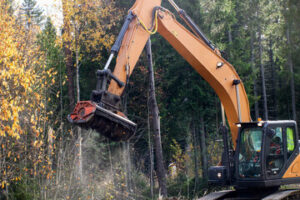Landscape lighting transforms your property into a mesmerizing wonderland at night. But installing it requires careful planning and safety.

Start by clearing your yard of all twigs, leaves, and rocks. Make sure the area is free of anything that could get in the way of your cable or wire connections. Click Here to learn more.
Landscape lighting not only enhances your outdoor spaces at night, it provides a range of other benefits as well. Safety and security are the most obvious, with brightly lit walkways making it safer for you and your guests to navigate in the dark. A well-lit yard also makes it less tempting for criminals to try their hand at trespassing and burglary.
Before you start purchasing light fixtures or setting out to draw up a design plan, it’s essential to take the time to determine which areas of your landscape should be highlighted and how. A few key factors to consider include identifying any obstacles that may be hazardous in the dark, such as low-hanging branches or uneven surfaces. Then, you’ll need to decide whether to use up lighting or down-lighting techniques.
Up-lighting is a popular way to add drama to the top of your home and other architectural features. On the other hand, down-lighting focuses the spotlight on ground level areas to create a soft glow. Depending on what your specific landscape goals are, you can opt for either of these effects, or combine them to achieve an even more layered appearance.
Another lighting technique is silhouette lighting, which highlights the dark shape of an object against the illuminated background. This effect works best with statues and other decorative elements that benefit from a bold, dramatic look. When using this technique, make sure the light you select has a large beam angle that can easily capture the outline of your object.
Grazing is a great option for highlighting textured walls and other flat surfaces. This is achieved by placing your light source up to a foot away from the surface and aiming it upwards or downwards to create shadows. Spot lights, well lights, and low-voltage landscape flood lights are commonly used for this purpose.
Moonlighting is a subtle way to highlight the natural beauty of trees and other landscape features. This effect is achieved by mounting a spot or low-voltage landscape light high in a tree and pointing it downwards to create a soft, warm glow. To create a more authentic look, it’s important to choose a bulb with a lower color temperature to mimic the warmth of natural moonlight.
Choose Your Fixtures
Choosing the right fixtures to illuminate your landscape is an important step in creating a well-designed lighting layout. This includes choosing the right bulb type and lumen output for each fixture, which impacts how brightly it will illuminate the space, and how much energy it consumes.
The right landscape lights can make your garden come alive with captivating ambiance after dark. From highlighting unique plant or garden features to creating a soft glow around trees and other focal points, there are many ways to highlight your landscape.
For example, using directional path lights to illuminate walkways or paths adds safety and functionality to outdoor spaces. Grazing is another technique that highlights the texture of a surface, such as brick, stone or wood, by placing light fixtures close to the ground, casting a wash of light that accentuates its details.
Up-lighting can transform majestic trees, delicate flowering shrubs and even garden statues into nighttime masterpieces. This technique is also ideal for illuminating architectural features and other garden structures, as it can draw the eye to their height and beauty.
When it comes to selecting the right fixtures, it’s essential that they are built to withstand the environmental demands of the outdoors. Plastic or recycled aluminum will hold up for a short time before it starts to corrode and crack, so look for metals like brass and copper, which can stand up to harsh weather conditions without rusting or failing.
In addition to choosing the right materials, you should also pay attention to the quality of the fixtures themselves. The more durable and well-built a fixture is, the less maintenance it will require in the long run. Finally, choose a system with high-quality connectors that are designed to be used in low-voltage electrical applications. Standard connectors can only be used for a brief period of time before they fail, so invest in gel-filled wire connectors that are specifically designed to be used in outdoor electrical installations.
With careful planning and the proper equipment, a homeowner can successfully install a low-voltage landscape lighting system. Creating a lighting plan will help you understand which fixtures you need, where to place them, and how to connect them with the correct gauge and length of cables. By taking the time to prepare for your installation, you can avoid potential problems down the line and enjoy your illuminated landscape for years to come.
Prepare for Installation
Professionally installed landscape lighting will not only add beauty to your home’s exterior, but it also enhances safety and security. It can make your outdoor living spaces usable day or night, and it can even increase the value of your property.
Before you start installing your lights, it’s important to prepare the area for the installation process. First, clear the yard of any debris or twigs that could get in the way of your cable and wire connections. Then, mark the area where you plan on putting your lighting fixtures, using stakes or twine. This will help you visualize where your lights will be placed, making the installation process much smoother.
When you’re ready to begin, it’s crucial to follow all electrical codes and use a qualified professional for complex installations. This will ensure the safety of everyone involved and reduce the risk of costly mistakes or injuries.
After your lighting has been installed, take a walk around the yard to inspect each fixture and make sure it’s working properly. This is the best time to note any potential problems, such as voltage drop or an insufficient connection. Fortunately, these issues are easy to resolve if they’re caught early on.
Once you’ve made any necessary adjustments, it’s time to turn on your new lights and enjoy the captivating ambiance they create. If you notice any glare or uneven light coverage, this is a good time to adjust your fixtures. Likewise, if your lights aren’t producing the desired effect, this is a sign that it’s time to switch the power source.
In addition to basic path and spot lighting, there are many other ways to illuminate your landscaping. For example, up-lighting and down-lighting can accentuate different features of your landscaping by creating dramatic shadows and contrasting light, respectively. Similarly, cross-lighting can highlight both sides of a hardscape or softscape feature to draw attention and showcase its unique shape. With so many options, it’s important to work with a knowledgeable and experienced landscape lighting professional. They can guide you through the entire process and help you achieve your dream backyard.
Install Your Lights
Lighting your landscape is a great way to extend the usability of your outdoor spaces well into the night. It also enhances the visual aspects of your yard and property, turning it into a mesmerizing wonderland of warmth and charm. Landscape lights not only add safety and security to your home and outdoor living areas, but they can also be used to highlight key natural and architectural features, such as trees, water features, statues, and garden paths.
The first step in installing a landscape lighting system is to assess your property. Take a walk around your yard during the day and at night to identify areas that require functional lighting for safety or security, as well as decorative lighting for aesthetics. This will help you plan your layout, get ideas for your lighting design, and determine how much effort this project will require. If you feel overwhelmed by the task at hand, it may be best to consult a landscape lighting professional.
Once you’ve chosen your fixtures, it’s time to prepare for installation. Begin by checking the location of underground utilities, clearing the area of any debris, and marking the locations where you will install each fixture. This will ensure that you don’t end up drilling through any pipes or cables. The next step is to determine the wattage that your fixtures will use and choose a transformer with sufficient power to handle the load. You can find the wattage of your fixtures by adding the total wattage of all the bulbs you’ll be using in each fixture.
When you’re ready to begin assembling your fixtures, follow the manufacturer’s instructions carefully. Remember to pay attention to detail, as any loose or incorrect connections can result in fire hazards and system failure. You should also be sure to properly strip the wire insulation and twist the ends of the wires securely before connecting them.
Once your landscape lighting is installed, you’ll want to program the timer and enjoy your newly illuminated yard. Be sure to adjust the lighting angles based on the season and to regularly clean your fixtures to keep them looking their best.








